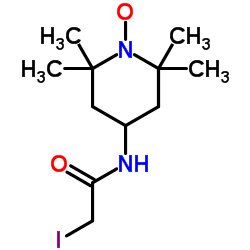Resolved conformational states of spin-labeled Ca-ATPase during the enzymatic cycle.
S M Lewis, D D Thomas
Index: Biochemistry 31(32) , 7381-9, (1992)
Full Text: HTML
Abstract
We have used frequency- and time-resolved electron paramagnetic resonance (EPR) to study the effects of substrate on the nanosecond conformational dynamics of the Ca-ATPase of sarcoplasmic reticulum, as detected by an iodoacetamide spin label (IASL) attached covalently to the enzyme. We confirm previous results [Coan, C. (1983) Biochemistry 22, 5826] showing that this probe is less rotationally mobile following the addition of nucleotides (ADP, AMPPNP, ATP) and that the shape of the spectrum suggests the presence of two components. We used two approaches to enhance EPR resolution in order to resolve the spectral components and their corresponding conformational states. First, to improve resolution in the frequency (spectral) domain, we used perdeuterated IASL, which results in narrower line widths. Digital spectral analysis resolves the EPR spectrum into two components, one that is indistinguishable from the spectrum observed in the absence of ligands and another that indicates more restricted probe motions, suggesting a distinct conformation of the labeled protein. Additions of substrate ligands appear to change only the mole fractions of the two components. The mole fraction of the restricted component (fR) was 0 in the absence of ligands, but increased to about 0.5 in the presence of saturating concentrations of AMPPNP and Ca2+. In general, ATP and its analogs increase fR, with larger effects observed in the presence of Ca. However, calcium has no effect by itself (fR = 0). Both monovanadate and decavanadate increase fR, but the formation of a covalent phosphoenzyme from inorganic phosphate (E2-P) had no effect (fR = 0).(ABSTRACT TRUNCATED AT 250 WORDS)
Related Compounds
| Structure | Name/CAS No. | Molecular Formula | Articles |
|---|---|---|---|
 |
4-(2-iodoacetamido)-tempo
CAS:25713-24-0 |
C11H20IN2O2 |
|
A paramagnetic molecular voltmeter.
2008-01-01 [J. Magn. Reson. 190(1) , 7-25, (2008)] |
|
Electron-electron spin-spin interaction in spin-labeled low-...
1995-06-01 [Biophys. J. 68(6) , 2531-42, (1995)] |
|
Phosphorylation regulates the ADP-induced rotation of the li...
1999-08-03 [Biochemistry 38(31) , 10107-18, (1999)] |
|
An iodoacetamide spin-label selectively labels a cysteine si...
1993-10-12 [Biochemistry 32(40) , 10803-11, (1993)] |
|
The characterization of vanadate-trapped nucleotide complexe...
1984-02-01 [J. Muscle Res. Cell Motil. 5(1) , 97-112, (1984)] |